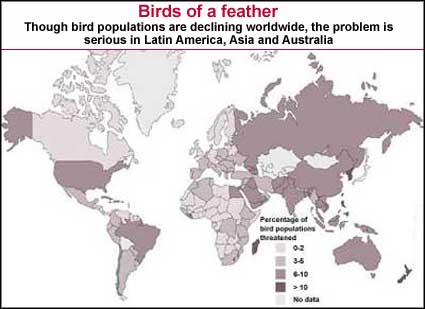Coffee not for birds
 About 11 per cent of all known bird species are threatened with extinction, according to the World Resources Institute. Fragmentation or loss of habitat is mainly responsible for this decline, but harvesting for food and trade and competition from introduced species are also responsible. For example, conversion of traditional coffee plantations, which serve as habitats for migratory birds, to industrial coffee production methods may have devastating consequences for migratory bird populations. This is especially true of Central America and Columbia, where many migratory routes converge. Studies in Columbia and Mexico show coffee plantations developed along modern lines support 90 per cent fewer bird species than traditional coffee plantations.
About 11 per cent of all known bird species are threatened with extinction, according to the World Resources Institute. Fragmentation or loss of habitat is mainly responsible for this decline, but harvesting for food and trade and competition from introduced species are also responsible. For example, conversion of traditional coffee plantations, which serve as habitats for migratory birds, to industrial coffee production methods may have devastating consequences for migratory bird populations. This is especially true of Central America and Columbia, where many migratory routes converge. Studies in Columbia and Mexico show coffee plantations developed along modern lines support 90 per cent fewer bird species than traditional coffee plantations.
More coffee, fewer birds? | ||||||
| In Latin America, coffee production has risen way above the world average, destroying the habitat of several bird species | ||||||
Production (000 metric tonnes) | Per cent change | |||||
| Region | 1950 | 160 | 1970 | 1980 | 1990 | 1950-90 |
| World | 2,222 | 4,268 | 4,262 | 5,039 | 6,282 | 183 |
| Central America | 189 | 341 | 428 | 605 | 680 | 680 |
| Caribbean | 107 | 136 | 121 | 134 | 139 | 30 |
| Northern Latin America | 711 | 1,102 | 1,214 | 1,707 | 2,104 | 196 |
| Source: Anon 1998, Global Environmental Trends, in World Resources 1998-99, World Resources Institute, UNEP, UNDP and the World Bank, New York, Oxford University Press, p166 and p197 | ||||||
Related Content
- The state of sustainability initiatives review 2014: standards and the green economy
- Monthly Overview on State of Environment, Nepal, January 2014
- Plastic materials pollute Kodaikanal environment
- Measuring and managing the environmental cost of coffee production in Latin America
- Attitudes and knowledge of shade-coffee farmers towards vertebrates and their ecological functions
- Bats limit insects in a neotropical agroforestry system
